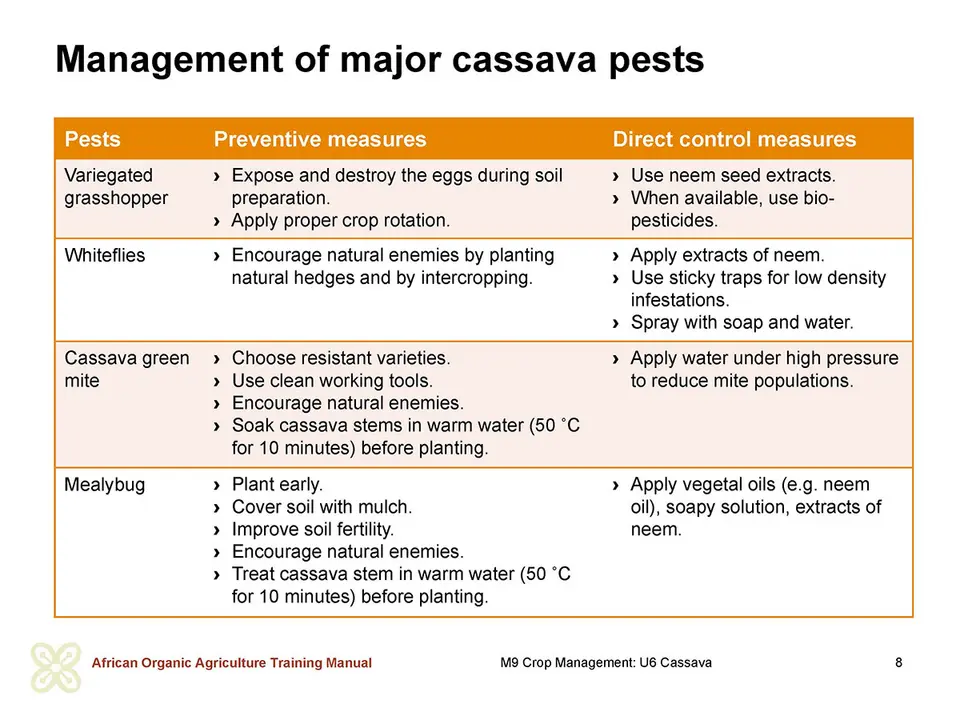Effective pest management
The major pests of cassava in sub-Saharan Africa are the cassava mealybug, the cassava green mite, the variegated grasshopper, whiteflies and vertebrate pests (rodents). Some feed on the leaves and stems while others feed on the stems and roots.
Leaf and stem feeders:
- The cassava mealybug (Phenacoccus manihoti) - reduces the lengths of the internodes and causes the leaves to clump together into ’bunchy tops’. The insect survives on cassava stems and leaves and is easily carried to new field. It can drastically reduce leaf and root yields, sometimes by as much as 80 %.
- The cassava green mite (Mononychellus tanajoa) - causes tiny yellow chlorotic leaf spots, the size of pin pricks, on the upper leaf surfaces. Heavily attacked leaves become stunted and deformed. Severe mite attack can result in 13 to 80 % loss in tuber yield.
- The variegated grasshopper (Zonocerus variegatus) - chews leaves, petioles, and green stems. It feeds on the plant leaves and the bark of the stems. The pest damage is more common in older cassava plants than younger plants, and is particularly severe during the dry season.
- Whiteflies - Two species of whiteflies mainly cause damage to cassava. Spiralling whiteflies (Aleurodicus dispersus) damage cassava by sucking sap from the leaves. As they feed, they secrete large amounts of honeydew that supports the growth of black sooty mould on the plant, causing premature fall of older leaves. Bemisia whiteflies (Bemisia tabaci) also suck sap from the leaves, but this does not cause damage to the plant. However, as they feed, the insects inject viruses into the plant, and thus transmit the cassava mosaic disease, one of the most important limiting cassava diseases in Africa.
Stem and root feeders:
- Termites - chew and eat stem cuttings, causing the cassava to grow poorly and die and rot. Many different kinds of termites damage cassava stems and tubers.
- Cassava root scale (Stictococcus vayssierrei) - causes the tubers to be smaller than normal and deformed.
- Cassava white scale (Aonidomytilus albus) - causes the stems to lose a lot of water and die.
Vertebrate pests:
Birds, rodents, monkeys, pigs, cattle, goats and sheep are common vertebrate pests of cassava. These pests, especially grass cutters (also known as cane rats), defoliate the crop by eating the leaves, green stems and tubers/roots after bulking and during late harvest.
Recommendations for farmers for pest management in cassava production:
In order to manage cassava pests, farmers should first and foremost identify the common pests, their damage symptoms and the conditions under which the pests will cause severe losses. This is done through closer monitoring and vigilance. Then they shall apply the following measures:
- Ensure field sanitation by planting healthy stem cuttings or treat the stem cuttings against pest damage. Avoid transporting and planting cassava stems infested with stem-borne pests. After harvesting, destroy cassava stems infested with stem-borne pests.
- Encourage natural enemies against cassava pests by encouraging hedge rows and flower strips along the field boundaries and within the crop fields respectively. Intercropping and agroforestry also help to encourage natural enemies. The most important natural enemies in cassava are: ants, spiders, ladybird beetles and predatory mites, which feed on green mites, parasitic wasps – which parasitizes the bugs – and whiteflies.
- Maintain strong and healthy plants by keeping adequate conditions (e.g. application of organic manure) healthy and free of pest planting material. Where possible, grow cassava varieties that tolerate the common pests in the local area.
- Apply plant extracts, for example, turmeric (Curcuma longa) against green mites or neem (Azadirachta indica) against whiteflies, when major damage is expected.
- When available, use biopesticides. For example, the International Institute of Tropical Agriculture (IITA) has developed a bioinsecticide consisting of naturally occurring fungual spores mixed in oil as a commercial product against grasshoppers. It does not damage other insects, plants, animals or people.
- In the control of birds, rodents and other vertebrate pests of cassava, fence-in the farm or the field and set traps in the fence. Cover exposed tubers with soil. Apply appropriate weed management of the cassava crop to discourage rodent pests in fields. And harvest cassava tubers as soon as they are mature.
Field visit
Visit different cassava fields andidentify together with the farmers any observable signs of pest and disease problems. Ask the participants, whether they are familiar with those signs of infection and whether they know, under which conditions the pests and diseases will cause severe losses.

 tap and then scroll down to the Add to Home Screen command.
tap and then scroll down to the Add to Home Screen command.